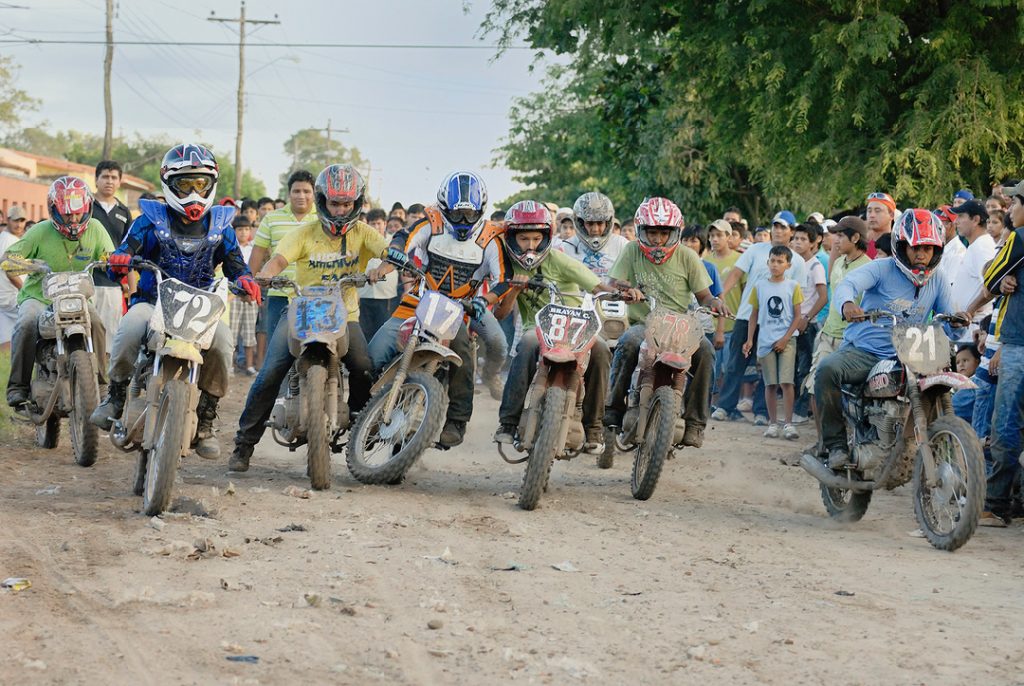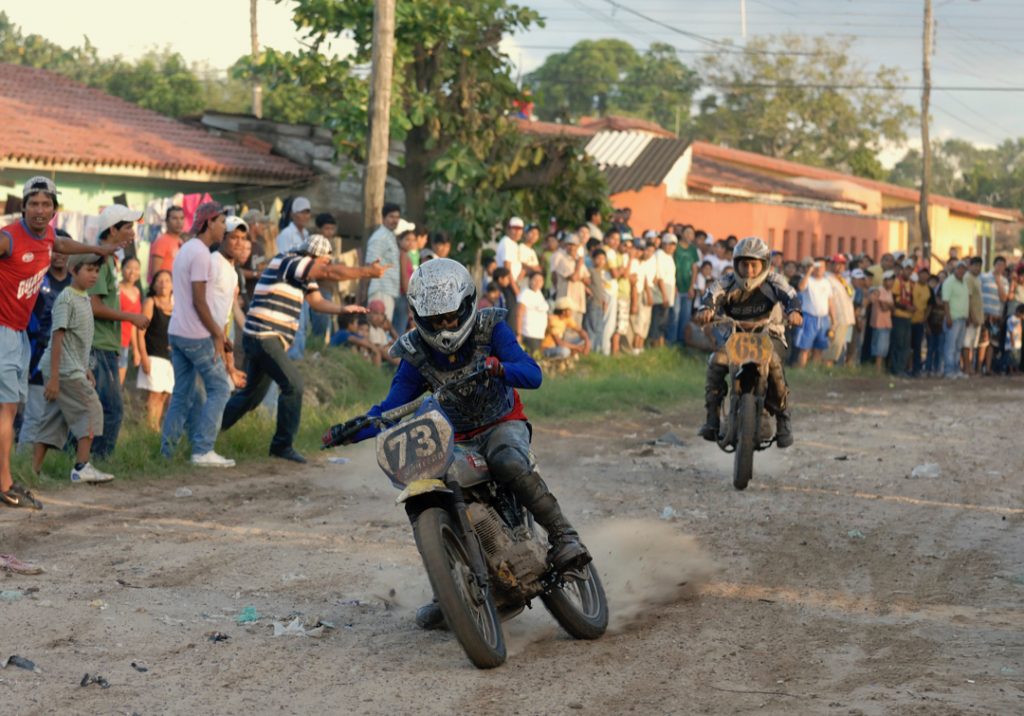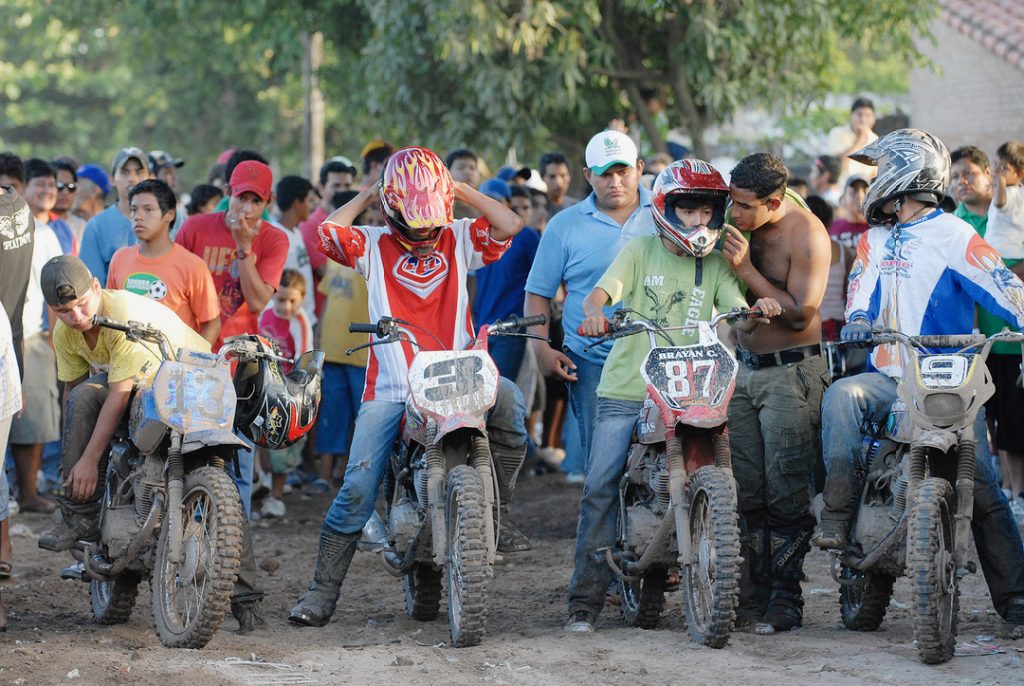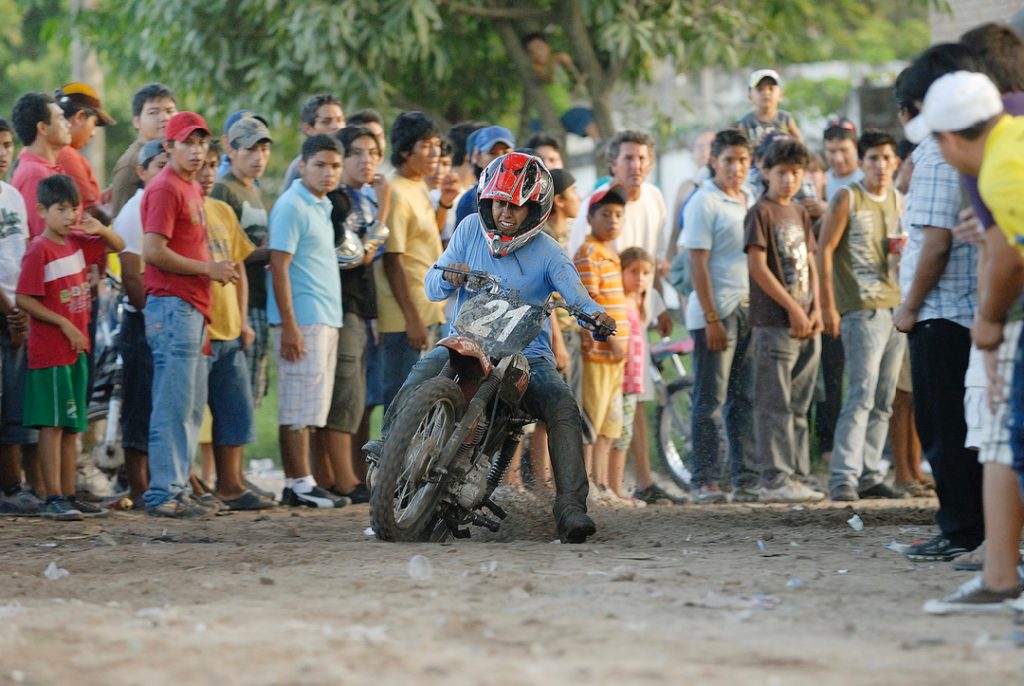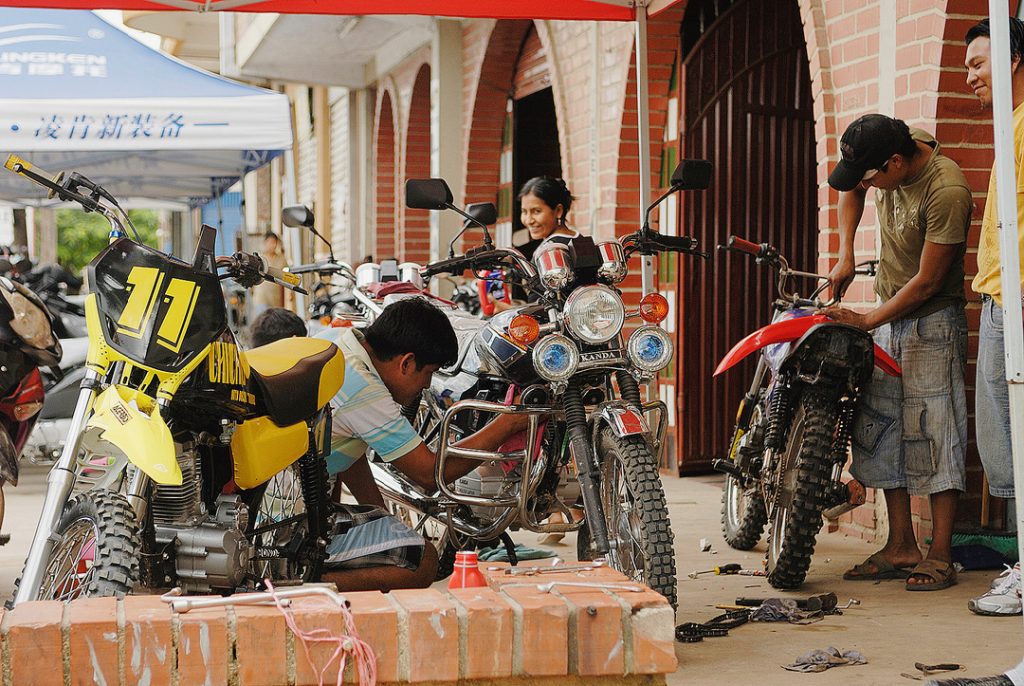WORDS AND PIC: FABRICE TULANE
There’s no room for mistakes. On this improvised circuit in the middle of a Bolivian village, losing it could mean crashing into a hut but there will certainly be a row of spectators to cushion the impact!
Here comes #22 but it’s not Chad Reed or Kevin Strijbos, this racer is from southern latitudes. Just out of Sunday mass, Pablo “Chincho” Gomez puts on a pair of gloves and kneepads, but no helmet, what for? He walks to the meeting point marked by Jesus Christ nailed to the cross, in the middle of the street. Other pilots are already there warming their engines.
Years ago, they would have attacked the “curve of death” at full speed, but the mayor asked for speed bumps to protect his citizens. Thus, with two wheelbarrows of concrete, he ensured his re-election.
Chinas Libres
Fifty kilometres north of Santa Cruz de la Sierra, the village of Montero is the stronghold of so-called “national” motorcycle races. For locals, the appearance of facial hair is the entry ticket to races organized in the streets, which are little more than dirt tracks cluttered with trash.
The pilots race an oval course on “panaderas” (bakers’) bikes that are mostly use on a daily basis: these kids are moto-boys (deliverymen) or moto-taxis. After a hard week of work, the little Chinese four-strokes are prepared on Sunday morning with the removal of superfluous parts and installation of homemade exhausts.
The displacement is limited to 150cc but, in the absence of scrutineering, some bump the little push-rod engines beyond 200cc. Built in neighbouring Brazil, the famous Honda CG125 is the ultimate weapon, but much-less expensive Chinese copies are very popular. So much so that the category has been renamed “Chinas Libres” (Chinese Free).
“Well prepared, a Chinese engine rips like a Honda, even more,” says Ruben. On reliability, he is less talkative but for less than $A700 you can have a new Yamasuki – yes, it’s a brand there! At this price you have a chassis made of soft metal that twists like marshmallow. In Bolivia, lots of motorcycles have their wheels out of whack, because the roads are so bad.
But the race bikes look the part with graphics copying the famous energy drink logos, Valentino Rossi’s number 46, Glen Helen or the local garage. Others put vindictive messages on their bikes. Antonio proudly runs an “I’m a dog” sticker on his.
Freestyle
In Bolivia everything is possible, but nothing is certain. When I arrived in the village, there were rumors of a race but we waited hours for confirmation. The organiser was nowhere to be found. I heard he was riding around in his car, studying a circuit in the dusty village while the mayor was taking the decision on whether to allow it or not.
Like Julius Caesar would have done, the mayor finally gave the people their hunger games. There were about 40 motorcycles shared by about 80 riders. As I sat in the shade of a mango tree, the unmuffled engines started in unison. It definitively woke me up.
While helmets may be adopted during races, bare heads suffice for the warm-up. Shirts are optional and the police are obviously busy elsewhere. Elbows rubbed and the engines screamed out their 15 or so horsepower. With so little grunt it was amazing to see what the riders were willing to do to make a pass. The demon late braking into the first turn demonstrated some big cojones (testicles).
There are official races organised by the Bolivian Federation of Motorcycling and a championship on proper tracks, with Montero’s Pablo Rea (see breakout) being the current title holder but he wasn’t racing at the village event.
The “I’m a dog” boy, Antonio takes off in his race and predictably launches into a fist fight on the track before his bike derails its chain, breaking the sprocket in the process.
Pushing the envelope, Hannibal leads the race on his Honda, running so wide that the rear tyre tosses tubs of old yoghurt and other detritus offered to Pacha Mama (Mother Earth) into the crowd with force.
They roar when Raúl loses one of his shiny shoes but the guy wants his prizemoney and remains in the race in his sock, risking permanent damage to his foot. In a “global village” ruled by political correctness and OHS, a small village of Bolivians is holding out.
THE CHAMP: 2018 CHINESE FREE WINNER PABLO REA
“I’m 27 and was born in Montero. I practiced motocross for a few years, but because of lack of money I settled down in the category called CG after the CG125. It might have a mellow engine but there’s always a way to hurt yourself!
“A few years ago, CG was running in parallel with motocross races, on a circuit around the MX track. The pilots came in jeans and road helmets with their small street motorbikes or mopeds. It was mostly to fill the time between the motocross heats.
“Recently, Chinese imports have grown exponentially in Bolivia and bikes are no exception. More Chinese copies of the CG125 are sold than the original, mainly due to their unbeatable price. On the track, the reliability is not always there because the engine is pushed out to 150, 200 or even 250cc to reach the power of the Honda.
“In short, today everyone has access to a motorcycle and wants to let off steam during the weekend. The BFM set up a championship called “125 CG” or “Chinese free” with a dozen dates on the calendar. They attract an important audience. So much so that the villages organize improvised races every Sunday, outside the official calendar.
“Bolivians identify more with this discipline, where he sees his daily motorcycle evolve, rather than attending the national motocross championship which is reserved for the rich. Bolivia is a poor country and our purchasing power is very low. The minimum wage is 1500 pesos bolivianos (about $A250).
“The BFM regulations limit cubic capacity to 150cc, but soon it could go up to 220cc. For my part, I race the Honda CG with which I am delivering during the week. The bike is reliable in its standard form and my preparation is limited to the exhaust pipe and fitting a larger carburettor.
“The chassis can be modified but, for financial reasons again, I did little, mostly cosmetics. The difference is in riding skills. Limited power and suspension do not forgive mistakes. You have to listen to your engine to get the best out of it or you will be left behind. The power goes flat very quickly and you have to play with the gearbox to take advantage of the narrow powerband. It’s a good driving school!”
Part 2 of Bolivian Village Races will be published in ADB issue #476 – May 2019.
